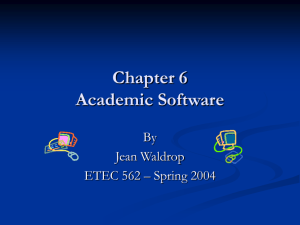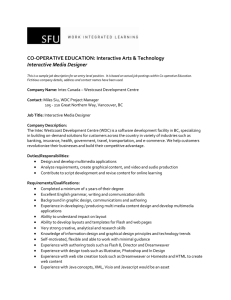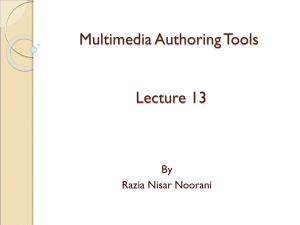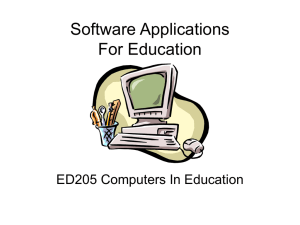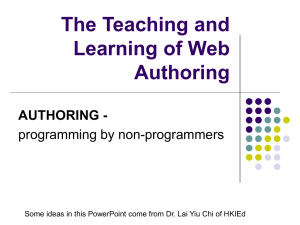Narratoria, an Authoring Suite for Digital Interactive Narrative Martin van Velsen
advertisement
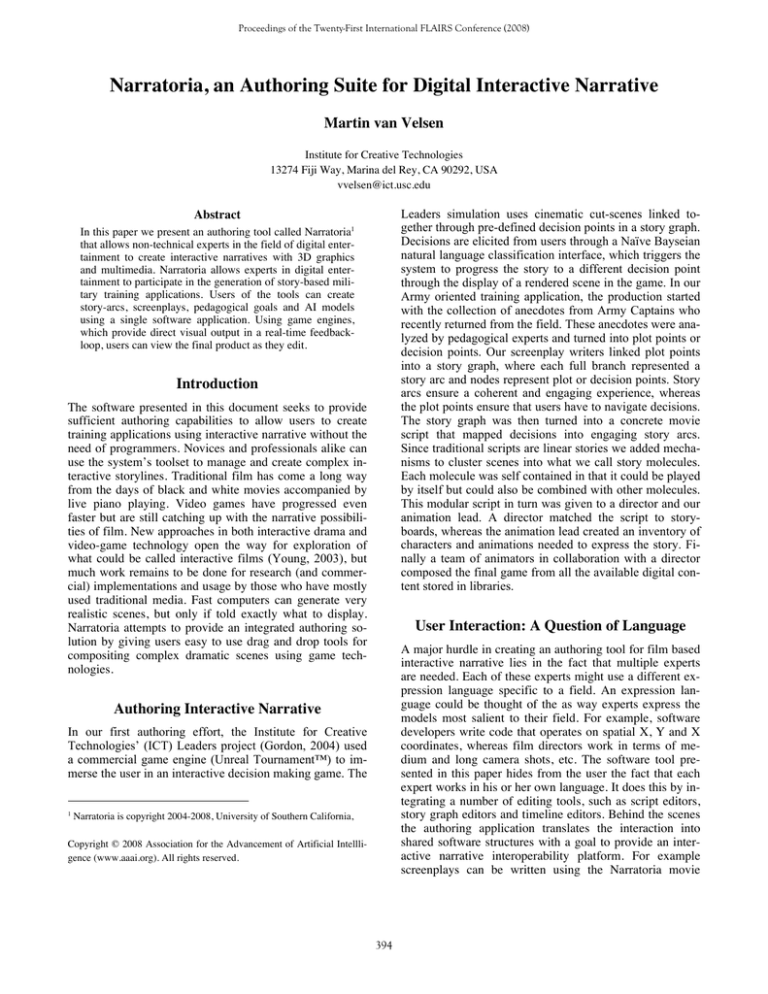
Proceedings of the Twenty-First International FLAIRS Conference (2008) Narratoria, an Authoring Suite for Digital Interactive Narrative Martin van Velsen Institute for Creative Technologies 13274 Fiji Way, Marina del Rey, CA 90292, USA vvelsen@ict.usc.edu Leaders simulation uses cinematic cut-scenes linked together through pre-defined decision points in a story graph. Decisions are elicited from users through a Naïve Bayseian natural language classification interface, which triggers the system to progress the story to a different decision point through the display of a rendered scene in the game. In our Army oriented training application, the production started with the collection of anecdotes from Army Captains who recently returned from the field. These anecdotes were analyzed by pedagogical experts and turned into plot points or decision points. Our screenplay writers linked plot points into a story graph, where each full branch represented a story arc and nodes represent plot or decision points. Story arcs ensure a coherent and engaging experience, whereas the plot points ensure that users have to navigate decisions. The story graph was then turned into a concrete movie script that mapped decisions into engaging story arcs. Since traditional scripts are linear stories we added mechanisms to cluster scenes into what we call story molecules. Each molecule was self contained in that it could be played by itself but could also be combined with other molecules. This modular script in turn was given to a director and our animation lead. A director matched the script to storyboards, whereas the animation lead created an inventory of characters and animations needed to express the story. Finally a team of animators in collaboration with a director composed the final game from all the available digital content stored in libraries. Abstract In this paper we present an authoring tool called Narratoria1 that allows non-technical experts in the field of digital entertainment to create interactive narratives with 3D graphics and multimedia. Narratoria allows experts in digital entertainment to participate in the generation of story-based military training applications. Users of the tools can create story-arcs, screenplays, pedagogical goals and AI models using a single software application. Using game engines, which provide direct visual output in a real-time feedbackloop, users can view the final product as they edit. Introduction The software presented in this document seeks to provide sufficient authoring capabilities to allow users to create training applications using interactive narrative without the need of programmers. Novices and professionals alike can use the system’s toolset to manage and create complex interactive storylines. Traditional film has come a long way from the days of black and white movies accompanied by live piano playing. Video games have progressed even faster but are still catching up with the narrative possibilities of film. New approaches in both interactive drama and video-game technology open the way for exploration of what could be called interactive films (Young, 2003), but much work remains to be done for research (and commercial) implementations and usage by those who have mostly used traditional media. Fast computers can generate very realistic scenes, but only if told exactly what to display. Narratoria attempts to provide an integrated authoring solution by giving users easy to use drag and drop tools for compositing complex dramatic scenes using game technologies. User Interaction: A Question of Language A major hurdle in creating an authoring tool for film based interactive narrative lies in the fact that multiple experts are needed. Each of these experts might use a different expression language specific to a field. An expression language could be thought of the as way experts express the models most salient to their field. For example, software developers write code that operates on spatial X, Y and X coordinates, whereas film directors work in terms of medium and long camera shots, etc. The software tool presented in this paper hides from the user the fact that each expert works in his or her own language. It does this by integrating a number of editing tools, such as script editors, story graph editors and timeline editors. Behind the scenes the authoring application translates the interaction into shared software structures with a goal to provide an interactive narrative interoperability platform. For example screenplays can be written using the Narratoria movie Authoring Interactive Narrative In our first authoring effort, the Institute for Creative Technologies’ (ICT) Leaders project (Gordon, 2004) used a commercial game engine (Unreal Tournament™) to immerse the user in an interactive decision making game. The 1 Narratoria is copyright 2004-2008, University of Southern California, . Copyright © 2008 Association for the Advancement of Artificial Intellligence (www.aaai.org). All rights reserved. 394 ration mechanisms are needed to support users remotely located working on data simultaneously. Finally, since the authoring software is targeted to be used by novices of interactive narrative, we need to provide easier ways to author training applications. script editor module, whereas film editors use the timeline editor module. Feedback is achieved through anchor points placed in the virtual environment, and are used for to place actors or to placing and moving cameras, etc. All other control over the world is achieved by having code interpret the intentions of the artists and by a director giving performance hints to the game engine. Further character performance is achieved by code that blends animations from a library in different ways to create new gestures. This blending is accessible from the timeline module where the final visuals are composed. The result resembles acts as a digital stage where directors interact with virtual actors. References Baecker, R., Rosenthal, A. J., Friedlander, N., Smith, E., and Cohen, A. 1996. A multimedia system for authoring motion pictures. In Proceedings of the Fourth ACM international Conference on Multimedia. Bulterman, D. C. and Hardman, L. 2005. Structured multimedia authoring. ACM Transactions on Multimedia Computing, Communications and Applications. Gebhard, P., Kipp, M., Klesen, M., and Rist, T. 2003. Authoring scenes for adaptive, interactive performances. In Proceedings of the Second international Joint Conference on Autonomous Agents and Multiagent Systems. Girgensohn, A., Shipman, F., and Wilcox, L. 2003. Hyperhitchcock: authoring interactive videos and generating interactive summaries. In Proceedings of the Eleventh ACM international Conference on Multimedia. Gordon, A., van Lent, M., van Velsen, M., Carpenter, M., and Jhala, A. 2004. Branching Storylines in Virtual Reality Environments for Leadership Development. Proceedings of the Sixteenth Innovative Applications of Artificial Intelligence Conference (IAAI-04), July 25-29, San Jose, CA. Menlo Park, CA: AAAI Press. Harada, K., Tanaka, E., Ogawa, R., and Hara, Y. 1996. Anecdote: a multimedia storyboarding system with seamless authoring support. In Proceedings of the Fourth ACM international Conference on Multimedia. Hill, R. W. Jr., Belanich, J., Lane, H., Core, M., Dixon, M., Forbell, E., Kim, J., Hart, J. 2006. Pedagogically Structured Game-Based Training: Development of the ELECT BiLAT Simulation. 25th Army Science Conference. Robertson, J. and Good, J. 2004. Children's narrative development through computer game authoring. In Proceeding of the 2004 Conference on interaction Design and Children: Building A Community. Ueda, H., Miyatake, T., and Yoshizawa, S. 1991. IMPACT: an interactive natural-motion-picture dedicated multimedia authoring system. In Proceedings of the SIGCHI Conference on Human Factors in Computing Systems: Reaching Through Technology. Young, R. M. and Mark, R. 2003. Towards an Architecture for Intelligent Control of Narrative in Interactive Virtual Worlds. In the Proceedings of the International Conference on Intelligent User Interfaces. Narratoria in Production, Preliminary Results The Narratoria authoring tools have been used in numerous projects at the ICT. In the ICT Leaders project before the introduction of authoring tools, animations were called by custom code in the game. Programmers moved the virtual actors around and had them speak lines using pre-recorded audio. Additional camera control code added means to place and move cameras. With this approach the screenplay took six months to implement. After introducing Narratoria into the pipeline the production time was reduced to three months. During the last three months of production, no programmers were needed to produce any of the content. We recently added a pedagogical authoring module for those games that use an automated tutor. For example, in authoring the ICT’s ELECT BiLAT game (Hill, 2006), authors use drag and drop techniques to associated learning objectives with game content that models a user’s interactions. An automated tutor then uses this information to track a student’s performance. Related Work Similar combinations of tools exist, which take on the separate areas of screenplay writing, movie-clip sequencing and animation creation (Robertson, 2004; Baecker, 1996), but none integrate the tools into one pipeline. Some more recent applications originating in the research community do allow traditional media types to be combined with novel abstract action sequences using XML documents but these systems either do not provide an intuitive mechanism for artists to access the materials (Gebhard, 2003; Bulterman) or they do not allow non-traditional actions such as character animation or camera actions to be used (Harada, 1996; Ueda, 1991). This research was sponsored by the U.S. Army Research, Development, and Engineering Command (RDECOM). Statements and opinions expressed herein do not necessarily reflect positions or policies of the U.S. Government; no endorsement should be inferred. Future Work With a framework in place that is targeted towards cinema style training applications we need to address a number of factors. First of all the software needs to be adapted to different forms of interactive narrative. Third, better collabo- 395
